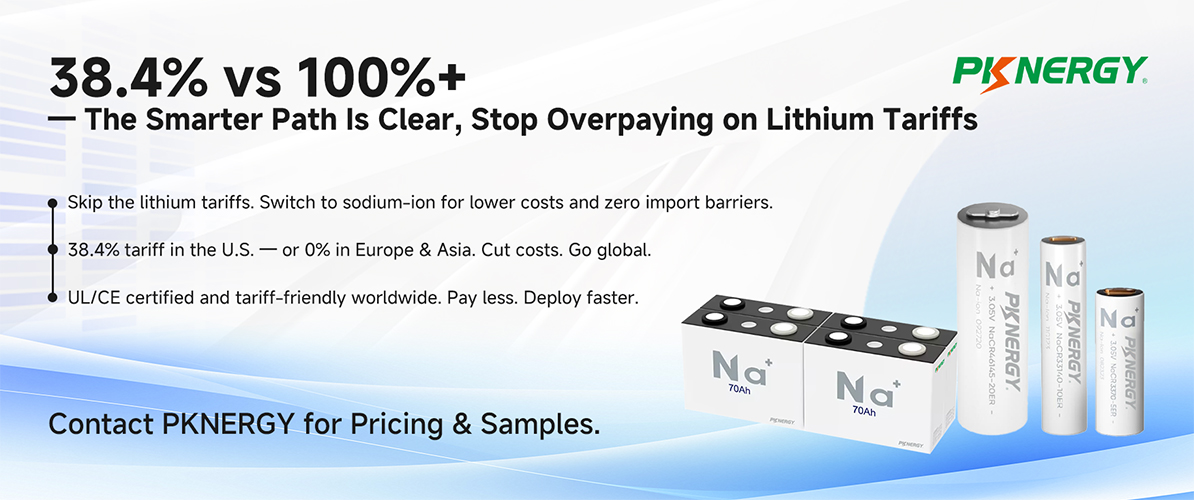Por que o íon de sódio é uma jogada inteligente de exportação
À medida que a demanda global por armazenamento de energia acelera, os fabricantes enfrentam uma escolha crítica: continuar pagando tarifas crescentes sobre baterias de íons de lítio ou explorar um caminho de exportação mais inteligente e econômico com baterias de íons de sódio.
Enquanto as baterias de íons de lítio estão cada vez mais sobrecarregadas por altas tarifas, taxas antidumping e restrições rígidas de importação, as baterias de íons de sódio atualmente evitam a maioria dessas barreiras comerciais.
Estados Unidos: íon de sódio 38,4% vs íon de lítio 100%+
Nos Estados Unidos, as baterias de íons de lítio enfrentam uma tarifa de importação combinada superior a 100%, considerando impostos básicos, medidas antidumping e tarifas da Seção 301.
Em contraste, as baterias de íons de sódio estão atualmente sujeitas a um imposto de importação total de apenas 38,4%, oferecendo uma vantagem de custo significativa para os exportadores.
Remover:As baterias de íons de sódio são tributadas em quase um terço da taxa das baterias de íons de lítio nos EUA
União Europeia: Tarifa de 0% para íons de sódio, taxas elevadas para lítio
A União Europeia impôs uma série de restrições comerciais às baterias de íons de lítio chinesas, incluindo:
-
Direitos antidumping e compensatórios
-
Requisitos de rastreabilidade e sustentabilidade
-
Inspeções alfandegárias e encargos com documentação
Em contraste,As baterias de íons de sódio atualmente desfrutam de tarifas zero na UE, sem nenhuma ação antidumping em vigor.
Remover:A exportação de íons de sódio para a UE atualmente é isenta de tarifas e enfrenta menos obstáculos políticos.
Ásia: Barreiras de importação mínimas ou inexistentes
Os principais mercados asiáticos — incluindo Índia, Coreia do Sul e Sudeste Asiático — não impuseram tarifas significativas sobre baterias de íons de sódio. A maioria dos países mantémtaxas de importação de zero a baixasem produtos de íons de sódio.
Enquanto isso, as baterias de lítio frequentemente enfrentam maior escrutínio ou controle regulatório nessas regiões.
Remover:Baterias de íons de sódio são bem-vindas em toda a Ásia com taxas de importação baixas ou nulas.
Íons de sódio vs. íons de lítio: vantagens de exportação em resumo
| Recurso | Bateria de íons de sódio | Bateria de íons de lítio |
|---|---|---|
| Tarifa dos EUA | ~38,4% | 100%+ |
| Tarifa da UE | 0% | Alto (direitos antidumping) |
| Tarifa da Ásia | 0–5% | Mais alto |
| Pressão política | Baixo | Alto |
| Tendência de Custo | Decrescente | Aumentando |
| Segurança e Meio Ambiente | Mais seguro e ecológico | Risco de incêndio/térmico |
Como construir uma estratégia de exportação de íons de sódio
A mudança para íons de sódio não só reduz custos, como também abre novas portas em mercados internacionais importantes. Veja como começar:
-
Avalie suas regiões de exportação
Priorize destinos como a UE e o Sudeste Asiático com impostos de importação mínimos. -
Aproveite as vantagens da conformidade
Baterias de íons de sódio são mais facilmente alinhadas a políticas de aquisição ecologicamente corretas e geralmente exigem menos certificação. -
Escolha o parceiro certo
Trabalhe com um fabricante de íons de sódio com experiência em logística internacional e conformidade regulatória.
Conclusão: Exporte com inteligência. Escolha íons de sódio.
Baterias de íons de sódio representam uma oportunidade rara para exportadores globais:barreiras comerciais mais baixas, pressões de custos reduzidas e crescente interesse dos compradores—enquanto as baterias de íons de lítio enfrentam crescente escrutínio regulatório e taxas mais altas.
Não pague a mais em tarifas de lítio.
Mude para íons de sódio. Exporte com inteligência.
Entre em contato conosco hoje mesmo para montar sua estratégia de exportação de íons de sódio.
Horário da publicação: 23/04/2025

